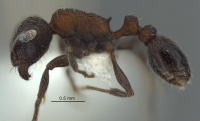Tetramorium oculatum
| Tetramorium oculatum | |
|---|---|

| |
| Scientific classification | |
| Kingdom: | Animalia |
| Phylum: | Arthropoda |
| Class: | Insecta |
| Order: | Hymenoptera |
| Family: | Formicidae |
| Subfamily: | Myrmicinae |
| Tribe: | Crematogastrini |
| Genus: | Tetramorium |
| Species: | T. oculatum |
| Binomial name | |
| Tetramorium oculatum Forel, 1913 | |
Known from open to semi-open habitats, e.g., grassland, open woodland, fynbos, T. oculatum has been collected by hand, pitfall traps, and a leaf-litter sample.
Identification
A member of the Tetramorium simillimum species group.
Bolton (1980) - A very conspicuous species, easily separated from all other members of the complex (and indeed all other members of the simillimum-group by its enormously developed eyes.
Keys including this Species
Distribution
Latitudinal Distribution Pattern
Latitudinal Range: 25.45° to -34.32333°.
| North Temperate |
North Subtropical |
Tropical | South Subtropical |
South Temperate |
- Source: AntMaps
Distribution based on Regional Taxon Lists
Afrotropical Region: Angola, Botswana, Mozambique, South Africa, Zimbabwe (type locality).
Distribution based on AntMaps
Distribution based on AntWeb specimens
Check data from AntWeb
Countries Occupied
| Number of countries occupied by this species based on AntWiki Regional Taxon Lists. In general, fewer countries occupied indicates a narrower range, while more countries indicates a more widespread species. |

|
Estimated Abundance
| Relative abundance based on number of AntMaps records per species (this species within the purple bar). Fewer records (to the left) indicates a less abundant/encountered species while more records (to the right) indicates more abundant/encountered species. |

|
Biology
Castes
Nomenclature
The following information is derived from Barry Bolton's Online Catalogue of the Ants of the World.
- oculatum. Tetramorium oculatum Forel, 1913a: 116 (w.) ZIMBABWE. See also: Bolton, 1980: 316.
Unless otherwise noted the text for the remainder of this section is reported from the publication that includes the original description.
Description
Worker
Bolton (1980) - TL 2.4-3.2, HL 0.60-0.78, HW 0.58-0.76, CI 94-97, SL 0.38-0.50, SI 63-67, PW 0.40-0.56, AL 0.70-0.94 (25 measured).
Mandibles longitudinally striate. Anterior clypeal margin entire, without trace of a median impression. Frontal carinae reaching back at least to level of posterior margins of eyes, sometimes slightly longer; carinae very feeble, no more strongly developed than the remaining cephalic rugular sculpture. Antennal scrobes vestigial. Eyes enormous, maximum diameter 0.22-0.28, about 0.37-0.39 x HW; in full-face view the eyes situated in the anterior half of the length of the sides, in profile curving down towards the ventral surface anteriorly. At the point where the anterior margin of the eye comes closest to the mandibular insertion the gap between the two is only about 0.25 x the maximum diameter of the eye, or even less. Head appearing roughly square in outline in full-face view, in fact slightly longer than broad (CI above). Metanotal groove impressed in profile. Propodeum armed with a pair of short triangular teeth. Metapleural lobes low and rounded. Petiole in profile with the height of the tergal portion of the node slightly greater than its dorsal length; in dorsal view the node distinctly broader than long. Dorsum of head finely longitudinally rugulose with a fine punctulate or granular ground-sculpture, fainter in small individuals than in large ones. Dorsal alitrunk rugulose with a conspicuous reticulate-punctate ground-sculpture. Dorsal surfaces of petiole, postpetiole and at least base of first gastral tergite densely finely reticulatepunctulate. Dorsal surfaces of head, promesonotum, petiole and postpetiole with short stout blunted hairs, such hairs absent from propodeum. First gastral tergite with appressed long greyish pubescence and with scattered, slightly elevated stout hairs. Ventral surface of head with a few very long curved hairs arising just posterior to the buccal cavity. Colour blackish brown to black.
Type Material
Bolton (1980) - Syntype workers, RHODESIA: Redbank, 7.iv.1912 (G. Arnold) (The Natural History Museum; Musee d'Histoire Naturelle Genève) [examined].
References
- Bolton, B. 1980. The ant tribe Tetramoriini (Hymenoptera: Formicidae). The genus Tetramorium Mayr in the Ethiopian zoogeographical region. Bulletin of the British Museum (Natural History) Entomology. 40(3):193-384.
- Forel, A. 1913a. Fourmis de Rhodesia, etc. récoltées par M. G. Arnold, le Dr. H. Brauns et K. Fikendey. Ann. Soc. Entomol. Belg. 57: 108-147 (page 116, worker described)
References based on Global Ant Biodiversity Informatics
- Bolton B. 1980. The ant tribe Tetramoriini (Hymenoptera: Formicidae). The genus Tetramorium Mayr in the Ethiopian zoogeographical region. Bulletin of the British Museum (Natural History). Entomology 40: 193-384.
- IZIKO South Africa Museum Collection
- Samways M. J. 1990. Species temporal variability: epigaeic ant assemblages and management for abundance and scarcity. Oecologia 84: 482-490.
- Willis C. K., J. D. Skinner, and H. G. Robertson. 1992. Abundance of ants and termites in the False Karoo and their importance in the diet of the aardvark Orycteropus afer. Afr. J. Ecol. 30: 322-334.

